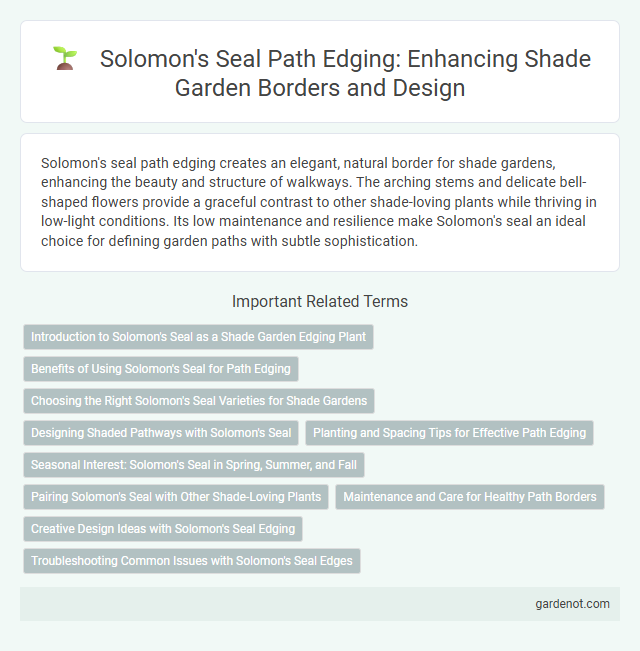Solomon's seal path edging creates an elegant, natural border for shade gardens, enhancing the beauty and structure of walkways. The arching stems and delicate bell-shaped flowers provide a graceful contrast to other shade-loving plants while thriving in low-light conditions. Its low maintenance and resilience make Solomon's seal an ideal choice for defining garden paths with subtle sophistication.
Introduction to Solomon's Seal as a Shade Garden Edging Plant
Solomon's seal (Polygonatum spp.) is an excellent choice for shade garden edging due to its graceful arching stems and variegated leaves that provide texture and visual interest. This hardy perennial thrives in low-light conditions, making it ideal for under trees or shady borders where other plants might struggle. Its delicate, bell-shaped flowers and striking foliage create a natural, elegant border that blends seamlessly into woodland garden settings.
Benefits of Using Solomon's Seal for Path Edging
Solomon's seal serves as an excellent choice for path edging in shade gardens due to its arching stems and lush, variegated foliage that create a natural, elegant border. Its shade tolerance and low maintenance requirements make it ideal for undercanopy planting, helping to suppress weeds and reduce soil erosion along pathways. The plant's slow, steady growth ensures a tidy edge while enhancing garden biodiversity by attracting pollinators such as bees and butterflies.
Choosing the Right Solomon's Seal Varieties for Shade Gardens
Selecting the right Solomon's seal varieties for shade gardens depends on factors such as leaf color, growth size, and flower characteristics. Varieties like Polygonatum odoratum 'Variegatum' offer striking variegated foliage that brightens low-light areas, while Polygonatum biflorum thrives in deep shade with elegant arching stems and fragrant bell-shaped flowers. Choosing disease-resistant cultivars adapted to your climate improves long-term garden health and visual appeal.
Designing Shaded Pathways with Solomon's Seal
Solomon's seal (Polygonatum) offers elegant, arching stems and lush green foliage that create a natural, graceful edge for shaded garden pathways. Its tolerance for deep shade and moist, well-drained soil makes it ideal for defining shaded walkways while enhancing texture and visual interest. Incorporating Solomon's seal as path edging promotes a serene, woodland ambiance that complements understory plants and softens hardscape elements.
Planting and Spacing Tips for Effective Path Edging
Solomon's seal thrives in shaded garden paths when planted 6 to 12 inches apart to create a lush, natural border that softens edges without overcrowding. Its arching stems and variegated leaves provide year-round interest while allowing sufficient airflow to prevent disease. Proper spacing ensures healthy growth and effective path edging, enhancing the aesthetic and functionality of shade gardens.
Seasonal Interest: Solomon's Seal in Spring, Summer, and Fall
Solomon's Seal provides vibrant seasonal interest along shade garden paths, showcasing delicate arching stems and tubular white flowers in spring. During summer, its lush green foliage offers a cooling, textured backdrop, while in fall, the leaves turn striking shades of yellow and gold, enhancing path edging with autumnal warmth. This perennial's multi-season appeal makes it a valuable and reliable choice for shaded landscapes.
Pairing Solomon's Seal with Other Shade-Loving Plants
Pairing Solomon's Seal (Polygonatum spp.) with other shade-loving plants like hostas (Hosta spp.) and ferns (Polystichum spp.) creates a textured, layered effect in a shade garden. The arching stems and variegated leaves of Solomon's Seal complement the broad foliage of hostas and the delicate fronds of ferns, enhancing visual interest and biodiversity. This combination also supports soil retention and improves microclimate conditions, ideal for maintaining moisture in shaded garden beds.
Maintenance and Care for Healthy Path Borders
Solomon's seal path edging requires regular pruning to remove yellowing or damaged leaves, promoting vigorous growth and maintaining tidy borders. Applying mulch around the plants helps retain soil moisture and suppress weeds, which supports overall plant health in shaded garden areas. Frequent monitoring for pests and diseases ensures early intervention, preserving the lush appearance and structural integrity of the path edging.
Creative Design Ideas with Solomon's Seal Edging
Solomon's seal path edging introduces an elegant, naturalistic border with its arching stems and variegated leaves, enhancing the shaded garden's serene atmosphere. Its graceful form pairs beautifully with ferns and hostas, creating textured layers that define walkways while promoting biodiversity. Incorporating Solomon's seal alongside woodland wildflowers offers a sustainable design choice, attracting pollinators and adding seasonal visual interest.
Troubleshooting Common Issues with Solomon's Seal Edges
Solomon's seal path edging often faces challenges such as encroachment of surrounding plants and uneven growth, which can create a messy border and disrupt the garden's aesthetic. Regular pruning and careful root barrier installation help maintain clear, defined edges and prevent Solomon's seal rhizomes from spreading uncontrollably. Monitoring soil moisture and light conditions ensures healthy, consistent growth, reducing patchy or weak edge formation in shade gardens.
Solomon’s seal path edging Infographic

 gardenot.com
gardenot.com